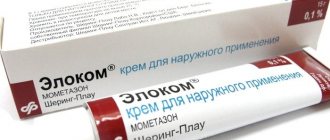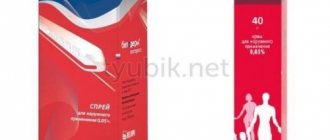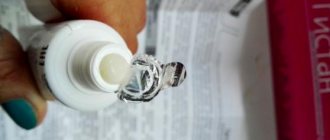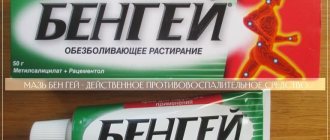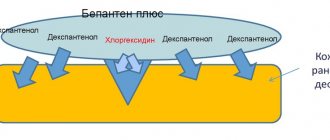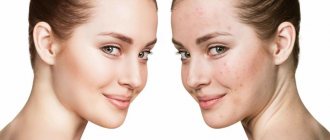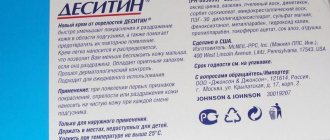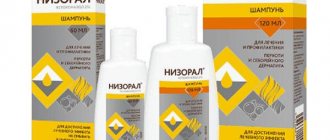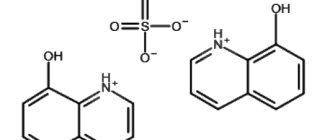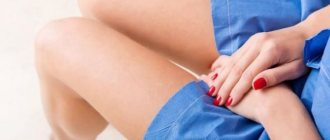Composition and release form
Nizoral is a white cream without foreign inclusions with a dense consistency and a specific odor. Italian and Belgian manufacturers package it in 15.0 g quantities in aluminum tubes. The screw cap is equipped with a protrusion for easy opening of the primary packaging. Each tube is enclosed in a cardboard box along with instructions for use. The drug has only one active ingredient - the antimycotic ketoconazole.
Popular packaging of cream in 15 g packaging
The auxiliary composition is represented by the following synthetic additives:
- propylene glycol;
- sorbitan stearate;
- cetyl and stearyl alcohols;
- polysorbates;
- isopropyl myristate;
- sodium sulfite;
- purified water.
Additional ingredients form a thick creamy base and ensure rapid distribution of ketoconazole in inflamed skin. And due to the formation of a thin and durable film, the risk of secondary infection is reduced.
The Nizoral therapeutic line also includes shampoo and oral tablets. In case of complicated dermatitis, these dosage forms are combined for a more powerful antifungal effect.
Three different forms of one drug
Price for Nizoral cream
For many patients who seek to effectively solve the problem of fungal diseases on the skin, the question of how much Nizoral costs is not fundamental. Buying the drug in pharmacies in Moscow and St. Petersburg is not difficult:
| Release form | Manufacturer | Price in rubles |
| Cream 2%, tube 15 g | D&D/Catalent/Silag | 570 |
| Janssen Pharmaceutica HB, Belgium | 541 | |
| Janssen-Cilag AG | 498 |
What is Nizoral cream
The drug is a homogeneous white cream exclusively for external use. Nizoral is not used in ophthalmic practice. Among patients, this drug is called Nizoral ointment. The drug is produced in tubes of 15 g, additionally packaged in cardboard boxes. It is recommended to store the product at a temperature of 15-30 degrees. The storage location must be inaccessible to children. The shelf life of the cream is 5 years. The use of Nizoral after the expiration date is not recommended.
Compound
The main active ingredient of Nizoral is ketoconazole, which is a synthetic derivative of imidazoledioxolane. The cream contains as excipients: purified water, propylene glycol, stearyl alcohol, cetyl alcohol, polysorbate 60, polysorbate 80, sorbitan stearate, isopropyl myristate, anhydrous sodium sulfite. The concentration of ketoconazole is 20 mg/g.
pharmachologic effect
The drug Nizoral is a synthetic broad-spectrum antifungal agent. Actively penetrates into the deepest foci of infection, has a unique therapeutic effect and an active mechanism of action. Nizoral has a fungicidal, mycostatic effect against fungi of the following genus:
- Trichophyton rubrum;
- Trichophyton mentagrophytes;
- Microsporum canis;
- Epidermophyton floccosum;
- Pityrosporum ovale;
- Candida.
Indications for use
Skin lesions caused by special types of microscopic fungi are indications for the use of Nizoral. Ketoconazole cream is prescribed for diagnosed skin diseases:
- dermatomycosis;
- epidermophytosis of the inguinal, hands, feet;
- skin candidiasis;
- seborrheic dermatitis;
- pityriasis versicolor;
- systemic skin lesions.
Analogs of Nizoral cream
The relatively high cost of the drug forces many patients to buy cheaper analogues of Nizoral. Among them, the creams Dermazol, Ketodin, Ketozoral, Ketoconazole, Sebozol, Mycozoral have proven themselves well. Analogues are much cheaper than the original product, but they contain ketoconazole as the main active ingredient, which guarantees their effectiveness. It is necessary to select analogues taking into account the individual reaction of the body to the components of any of the mentioned drugs.
Mechanism of action of the drug
Based on a decrease in the synthesis of protein in the cell wall of fungi. Due to this, there is a decrease in activity and growth. When using this drug, conditions are created for the death of fungi. Due to the reduction in the production of ergosterol, the main component of the cell, a fungicidal effect occurs. The drug also has a fungiostatic effect. That is, a new number of mushrooms are not formed. Two such effects allow you to completely get rid of fungal flora.
In addition, the second component in the mechanism of action is the interaction of the active substance with cell enzymes. Due to this, a large amount of free oxygen is formed and the complete death of the mushrooms occurs.
The active substance also has a slight antimicrobial effect. It manifests itself in the form of a bacteriostatic effect. Applies to staphylococci and streptococci. Thanks to this, the formation of secondary complications in fungal diseases of the skin and mucous membranes does not occur.
The composition also includes additional components. They are secondary and do not have any effect on fungal cells.
Methods of application
To obtain the desired effect, the cream should be applied in a thin layer several times a day. The duration of treatment ranges from 1 to several weeks. For skin candidiasis, apply the cream twice a day. In this case, the skin area must be thoroughly cleaned before application. This promotes better penetration of the active substance into the surface layer of the skin and the development of a fungicidal effect. Then the ointment must be applied in a small amount to the affected area.
When treating trichophytosis and microsporia, the use of ointment is required at least 3 times a day. To do this, apply a thin layer of cream to the area with fungal infection. If necessary, you should shave an area of the scalp if the fungal infection is located there.
Dermatophytosis is recommended to be treated for 3 weeks. In this case, the cream should be applied even after the symptoms have subsided.
This is important, since mushrooms are among those capable of sporulation. Therefore, longer use of medications is required for complete recovery.
Onychomycosis is treated within 2 weeks. As a rule, several more courses of treatment are required. Since this disease requires careful and long-term use of drugs. When treating seborrhea of the head, the cream must be applied at night for 3 weeks. Then take a break for three months. And then you should repeat the treatment again.
Analogs
Nizoral cream cannot be classified as a budget product; in addition, individual intolerance to one of the components is possible, so it is extremely important to know what, if necessary, can replace the drug. Analogues of the cream are produced on the basis of the same active substance
Medicines with similar effects are made on the basis of a different active ingredient, but provide the necessary therapeutic effect
Analogues of the cream are made on the basis of the same active substance. Medicines with similar effects are made on the basis of a different active ingredient, but provide the necessary therapeutic effect.
List of pharmaceutical medications that can be an alternative to Nizoral cream:
Name Active component Features of action Contraindications Method of use Cost Dermazole Keto-conazole Local and systemic treatment of mycoses Hypersensitivity; Lactation and pregnancy; Age up to 3 years; Adrenal diseases
Treatment of affected areas 1-2 times a day Duration of therapy up to 30 days. 180 RUR Mycozoral Keto-conazole Therapy of mycoses, lichen and dermatitis Violation of the integrity of the dermis, bruises, abrasions; Older age; Intolerance to components; Pathologies of the liver, kidneys, pituitary gland
Application to problem areas until symptoms are eliminated RUB 170 Keto-conazole Keto-conazole Candidiasis, lichen, dermatitis, epidermophytosis Injuries at the sites of application; Intolerance to active substances
For the treatment of the disease, treatment of the dermis twice a day, for maintenance therapy - 2 times a week 60-100 rubles Ketodin Keto-conazole Therapy of diseases caused by yeast and mold fungi, spores Hypersensitivity Treatment of affected areas 1-2 times a day day 150 R Ketozoral Keto-conazole Dermatitis, skin infections, lichen Intolerance; pregnancy
Application to problem areas for up to one and a half months RUR 450 Sebozol Keto-conazole Damage to nails, hair, skin Pathologies of the liver and kidneys; Individual intolerance; pregnancy and breastfeeding
Lubricating inflamed areas 150 RUR Mycoket Keto-conazole Antifungal drug Hypersensitivity Applying the composition to inflamed areas of the skin 130 RUR Zalain Serta-conazole nitrate All types of mycoses of the skin and scalp Individual intolerance Lubrication with a thin layer covering the healthy area derma 500 RUR Candibene Clotrimazole Anti-bacterial and anti-fungal drug for the treatment of lichen, candidiasis and mycosis First 3 months of pregnancy; Increased sensitivity
Rubbing into dry areas of the skin 2-3 times a week 30-180 RUR Kanestan Clotrimazole Candidiasis, mycoses, lichen Intolerance; Children - with caution
Cream treatment of diseased skin areas 3 times a day 450 RUR
According to research and the opinion of dermatologists, Nizoral is an effective cream that helps cope with a wide range of dermatological diseases and fungal infections.
Compliance with medical prescriptions and recommendations contained in the instructions for use is the key to a quick and final recovery, as well as getting rid of diseases that not only cause discomfort, but also provoke the manifestation of cosmetic imperfections.
Author of the article: Dakian Anna Vladimirovna
Article design: Oleg Lozinsky
Special instructions for the use of Nizoral cream
If Nizoral cream is applied to areas treated with corticosteroid ointments, it is recommended to apply corticosteroids in the morning, and Nizoral cream in the evening, then gradually, over 2-3 weeks, stop steroid therapy. During pregnancy and breastfeeding. Since the drug is practically not resorbed and does not enter the systemic circulation, its use is possible during pregnancy and lactation. Does not affect the ability to drive vehicles or operate equipment.
Use of tablets
The mechanism of action is fungicidal and fungiostatic. The effect is achieved within a few hours after taking the tablets.
The prescription of tablets for fungal diseases occurs in the case of systemic development of mycosis. In addition, they are used for severe and recurrent candidiasis of the mucous membranes. These include:
- vaginal candidiasis;
- recurrence of fungal infection of the esophageal mucosa;
- long-term persistent oral mycosis.
Another indication for oral administration is the lack of effect from previous therapy. Also, if the patient has increased sensitivity to the use of external forms. For prevention, tablets can be used in people with low immunity.
Side effects in this case occur against the background of increased concentration in the systemic circulation. Dyspeptic disorders may occur from the gastrointestinal tract. Headaches and increased fatigue are noted. Sometimes liver dysfunction is observed. There were no side effects from the immune system. Sometimes photophobia may occur. Uncommon: minor nosebleeds.
All side effects are included in the instructions after a certain period of use. Even the presence of one case is subject to registration.
Popular ketoconazole-based shampoos
Shampoos with ketoconazole are designed to eliminate itching, skin irritation and excess flaking of the scalp. As an external remedy for the treatment of mycoses, shampoos are quite safe: the active substance does not have a systemic effect on the body.
Among the undesirable effects that can be expected from the use of medicated shampoos is increased dryness or oiliness of the hair. If the hair is gray or chemically damaged, its structure is disturbed, and some change in color may be observed.
The most popular medicinal ketoconazole-containing shampoos:
- Nizoral;
- Mirolla Sulsen Forte;
- Mycozoral;
- Sebozol;
- Horsepower;
- Dandruffed;
- Keto plus.
Application: medicated shampoo is applied to the hair and scalp in the same way as regular shampoo. Massage the skin with your fingers, foaming the shampoo. After 5 minutes, the hair is washed with warm water.
In between using anti-dandruff shampoo, you can use your usual hair cleanser.
Comparative table of popular anti-dandruff shampoos with ketoconazole (average prices for the second half of 2021):
| Name | Ketoconazole concentration | Indications | Volume and price |
| Nizoral (Belgium) | 2% | pityriasis versicolor, seborrheic dermatitis, dandruff | 120 ml – 900 rub., 60 ml – 700 rub. |
| Mirolla sulsen forte with ketoconazole (Russia) | 2% + selenium disulfide (sulsen) | dandruff | 150 ml – 200 rub., 250 ml – 250 rub. |
| Mikozoral (Poland, Russia) | 2% | pityriasis versicolor, seborrhea | 60 ml (bottle) – 400 rub., 150 g (tube) – 550 rub. |
| Sebozol (Russia) | 1% | seborrheic dermatitis, pityriasis versicolor, seborrheic forms of psoriasis and atopic dermatitis | 100 ml – 350 rub., 200 ml – 500 rub., pack of 5 bags of 5 ml – 165 rub. (each package is designed for one use) |
| Horsepower anti-dandruff shampoo with ketoconazole (Russia) | 2% or 1% | dandruff | 100 ml (Forte 2%) – 600 rub., 250 ml (1%) – 660 rub. |
| Perhotal (India) | seborrhea, pityriasis versicolor, diaper rash in the groin, vulgar sycosis | Available in bottles of 25, 60 and 100 ml. Cost from 227 to 562 rubles, depending on the volume and concentration of the active ingredient. | |
| Keto Plus (India) | 2% + zinc pyrithione | seborrhea, pityriasis versicolor | 60 ml – 600 rub. |
Which is better: pros and cons
Perhotal and Sebozol are distinguished by a variety of dosages. Small packages are suitable for short courses of treatment - it is convenient. At the same time, Sebozol is almost half the price, but it has only a 1% concentration of ketoconazole (usually this is enough to eliminate dandruff if used without skipping and left for 5 minutes before rinsing).
Mirolla brand shampoos are among the cheapest in terms of bottle volume, and indications for their use are limited to dandruff.
The drug with the widest range of uses, but at the same time the most expensive, turns out to be Nizoral.
Horsepower and Keto Plus belongs to pharmaceutical shampoos of the mid-price category; the latter additionally contains zinc pyrithione for the fastest possible removal of dandruff. The cheaper Indian competitor Perhotal contains a conditioner and its therapeutic potential is quite satisfactory.
Nizoral tablets: composition and pharmacological properties
Nizoral tablets are round in shape and white in color. Sealed in blisters in quantities of 10 pcs. There are 1 or 3 blisters in a cardboard package. Each tablet contains 200 mg of ketoconazole - this is the active substance of the drug.
Nizoral also includes:
- Water.
- Polividone.
- Lactose monohydrate.
- Corn starch.
- Magnesium stearate.
- Colloidal anhydrous silicon dioxide.
- Microcrystalline cellulose.
The active substance ketoconazole is an imidazole-dioxolane derivative. The compound has fungicidal properties that are detrimental to dermatophytes, dimorphic strains, yeast flora and higher eumycete fungi. The causative agents of aspergillosis, sporothrix fungi, mucor, dermatica and other phycomycetes show less sensitivity to the effects of ketoconazole.
What does ketoconazole do? The substance inhibits the synthesis of ergosterol in mycelial cells. For this reason, the composition of the membrane components is disrupted and the fungi die. The highest concentration of ketoconazole is observed 1 to 2 hours after taking the medicine. The substance is distributed throughout the internal tissues, penetrating into the cerebrospinal fluid in minimal quantities. After oxidation and breakdown, the drug is excreted in urine and bile.
Indications and contraindications
You can find out what Nizoral tablets help with in the instructions for use. The drug has many indications, so it is widely in demand in dermatology and mycology.
When is Nizoral prescribed:
- Histoplasmosis.
- Blastomycosis.
- Dermatophytosis.
- Oral candidiasis.
- Tinea versicolor.
- Paracoccidioidosis.
- Fungal infections of the dermis, mucous membranes and scalp.
- Chronic recurrent vaginal candidiasis.
- Fungal folliculitis (caused by Malassezia).
- Chronic candidiasis of the skin or mucous membranes.
Nizoral tablets also have many contraindications, so taking them without medical prescription is unacceptable.
Under what conditions is Nizoral contraindicated:
- Liver pathologies.
- Age under 3 years.
- Pregnancy and lactation.
- Lactose intolerance.
- Individual intolerance to the components.
- Concomitant use with oral medications Bepridil, Sertindole, Mizolastine, Terfenadine, Disopyramide, Quinidine, Triazolam, Midazolam, Simvastatin, Ergotamine, Ergometrine, Irinotecan, Nisoldipine, etc. The list is very long, so always consult your doctor if you are already taking medications.
Nizoral should be prescribed with caution to patients with low gastric acidity. For patients with a history of achlorhydria and those taking histamine H-2 receptor blockers or proton pump blockers, Nizoral is recommended to be taken with cola drinks.
How to treat fungus with Nizoral tablets
According to the instructions for use, Nizoral tablets are taken with food for better absorption of medications. For vaginal candidiasis, 2 tablets are taken daily for 1 week.
Fungal infections of the skin of the body and head, dermatophytosis and systemic infections are treated daily by taking 1 tablet of Nizoral. If there is no improvement after some time, the dosage is increased to 2 tablets per day. For dermatophytosis, treatment lasts 4 weeks, for fungal seborrhea of the head - 6 - 8 weeks, for lichen versicolor - 10 days. Systemic mycoses are treated for six months.
If Nizoral is prescribed for the treatment of nail fungus, it is taken for a long time, 4–6 months. The period depends on the growth rate of the plate. Therapy is completed at the stage when the affected nails are completely replaced by healthy ones, and laboratory tests show the absence of pathogenic flora.
It is prohibited to increase the dose of ketoconazole without the knowledge of the doctor. An overdose causes abdominal pain, nausea, drowsiness, flushing, diarrhea, vomiting, anorexia, swelling, hyperhidrosis, rash, headaches, and decreased appetite. The patient's gastric lavage is performed according to indications, mainly using enterosorbents.
Video:
https://youtube.com/watch?v=jxX5vw4arZk
Price and analogues
The price for Nizoral tablets is not too high - 3 blisters can be bought for 350 - 400 rubles. In some pharmacies the drug is sold at a higher price. The final cost depends on the manufacturer and the trade markup of a particular pharmacy.
Considering the duration of treatment for fungal diseases, the consumer understands that the purchase of Nizoral will ultimately result in a tidy sum. This raises the question of whether there are analogues of Nizoral tablets - cheaper, but just as effective.
Pharmacists offer two options to replace Nizoral tablets - Ketoconazole and Mycozoral. If the doctor additionally prescribed shampoo, but it did not work, Nizoral is replaced with Kenazol, Orazol, Perhotal, Ebersept, Sebozol.
Pharmacological properties
The high therapeutic activity of Nizoral is determined by the presence of ketoconazole in its composition. This imidazole derivative selectively acts on the human body, penetrating only into tissues affected by the fungus. Ketoconazole inhibits the enzyme that stimulates the production of ergosterols. The lack of these proteins leads to increased permeability of fungal cell membranes. They gradually dissolve and break down, which causes the death of infectious pathogens. Using the cream allows you to achieve numerous therapeutic effects:
- reducing the severity of pain, itching, burning;
- weakening of both acute and chronic sluggish inflammatory processes;
- resorption of edema, reduction of local temperature.
Simplified scheme of action of the drug
Many pathogenic fungi, but especially dermatophytes, are sensitive to ketoconazole. The ability of the antimycotic to first inhibit and then destroy pathogenic bacteria has been noted. Therefore, during the treatment of mycoses, penetration of staphylococci and streptococci into the inflamed tissues is extremely rare.
Contraindications and side effects of Nizoral cream
In case of individual hypersensitivity to the main active ingredient ketoconazole and other active components of the cream, Nizoral is contraindicated. Pregnancy and lactation are not contraindications to the use of Nizoral cream. There have been no clinical trials on its effect on pregnant women. The same can be said about the effect of Nizoral cream on nursing women.
When using a medicinal product, you may sometimes experience burning and irritation of the skin; allergic reactions rarely occur.
For this reason, the drug is prescribed with caution to patients with allergies. In case of an overdose of the drug, local erythema, rash, and swelling are observed.
These manifestations disappear with dosage use of the drug and after the end of the therapeutic course.
No interactions of Nizoral cream with other drugs have been identified. The use of the ointment is safe for patients with diagnosed liver and kidney diseases. External use of the drug prevents the active substance from entering the blood. When treating with corticosteroids, Nizoral is recommended to relieve the symptoms of the drugs after their long-term topical use. For this purpose, local corticosteroids are used in the morning, and Nizoral in the evening for 2-3 weeks. After this, steroid therapy is discontinued.
Indications for use
Nizoral ointment (cream, gel) is intended for the treatment of dermatological diseases from the group of mycoses. Clinically, such pathologies are manifested by intense skin itching, the formation of swelling and redness. The antifungal drug has proven itself in the treatment of such pathologies:
- pityriasis versicolor, affecting only the stratum corneum of the epidermis;
- psoriasis at the stage of formation of papules and plaques;
- seborrheic dermatitis caused by increased sebum secretion;
- dermatomycosis of various localizations.
Seborrhea of the scalp is also an indication for use of the product. But usually, when diagnosing this disease, dermatologists prefer to prescribe Nizoral shampoo to patients. Ketoconazole from this dosage form penetrates faster into inflammatory foci.
Previously, the cream was often used in the treatment of mixed skin infections. Recently, many combined agents have been synthesized that are more convenient to use. Therefore, when a bacterial skin lesion combined with mycoses is detected, Nizoral is prescribed quite rarely.
Contraindications
Use with caution.
The only absolute contraindication to cream treatment is individual intolerance to the ingredients. This is true not only for ketoconazole, but also for auxiliary components.
Nizoral should be used with caution in severe pathologies of the liver, kidneys, and cardiovascular diseases.
The drug is included in therapeutic regimens during pregnancy and lactation. According to the results of clinical studies, it does not have a teratogenic effect. But Nizoral is prescribed to a child or pregnant woman only if safer means are ineffective. For this group of patients, it is recommended not to apply the cream to large areas of the body.
It must be taken into account that at the initial stage of therapy, a short-term, reversible decrease in testosterone levels is possible. But the drug itself is not a hormonal drug. Therefore, contraindications to treatment with glucocorticosteroids are not typical for him.
Instructions for use
Nizoral ointment is used externally once a day. A small amount of the drug is applied to the affected area and adjacent skin. The duration of use can be from 2 to 6 weeks and depends on the nature of the disease.
When treating skin diseases, it is necessary to observe rules of personal hygiene to prevent re-infection. The method of applying the ointment is the same in all cases. The only difference is the duration of therapy:
- pityriasis versicolor and other infections caused by pathogenic yeast bacteria - from 2 to 3 weeks;
- epidermophytosis of the inguinal and skin of the feet - from 2 to 4 weeks;
- epidermophytosis of smooth skin - from 3 to 4 weeks;
If after a month after the start of use there are no positive changes, it is necessary to clarify the diagnosis.
When treating nail fungus, you must first clean the nail plate and adjacent skin. It is necessary to rub the medicine until completely absorbed. In accordance with the instructions, it is recommended to use the drug once a day before bedtime. Twice use can only be allowed in case of very severe damage. In this case, to enhance the therapeutic effect of the ointment, nizoral tablets can be prescribed.
For seborrheic dermatitis, the ointment is applied once or twice a day. Regular use allows you to get rid of the symptoms of the disease in a few days. After complete recovery, it is recommended to use nizoral for prophylaxis no more than once a week.
Indications
Nizoral ointment is an extended-spectrum antifungal drug. Most often it is prescribed for fungal nail infections, but there are many other problems that it solves no less effectively:
- cutaneous candidiasis;
- dermatitis and dermatomycosis;
- epidermophytosis (groin, hands and feet);
- pityriasis versicolor.
The duration of the course of use is determined by the attending physician.
Contraindications and side effects of nizoral ointment
The drug nizoral is not absorbed into the blood and is not toxic, so the list of contraindications for its use is small:
- individual intolerance to the active substance - ketoconazole;
- allergic reactions, manifested in the form of swelling and rash.
Nizoral ointment can be used during pregnancy and lactation. Its use does not in any way affect the functioning of the main internal organs, as a result of which the drug can be prescribed to patients with diagnosed pathologies in the liver and kidneys.
special instructions
Nizoral ointment is used externally only. It should not be used to treat fungal eye infections.
To prevent withdrawal syndrome when using corticosteroids, the following dosage regimen is recommended:
- Take the drug in the morning, apply Nizoral ointment in the evening;
- Gradually stop using steroids over a period of no more than three weeks.
It is recommended to pack expired or spoiled medicines in a plastic bag and place them in a trash container.
Nizoral for fungus
According to the pharmacological classification, Nizoral belongs to antifungal agents that act on pathogens of skin and hair diseases. The medication has three release forms, the active ingredient in which is ketoconazole, a component that inhibits the growth and development of fungi. Nizoral is prescribed by a doctor, depending on the individual characteristics of the patient and the degree of the disease.
Composition and release form
Nizoral is presented in three release formats, similar in active substance. The full composition of each of them, according to the instructions, is presented in the table:
| Shape/Characteristics | Nizoral ointment | Shampoo | Pills |
| Ketoconazole concentration | 20 mg per 1 g | 200 mg per 1 piece. | |
| Auxiliary components | Propylene glycol, stearyl alcohol, cetyl alcohol, sorbitan stearate, polysorbate, isopropyl myristate, anhydrous sodium sulfite, purified water. | Sodium lauryl sulfate, disodium lauryl sulfosuccinate, coconut fatty acid diethanolamide, collagen hydrolysate, macrogol methyl dextrose dioleate, sodium chloride, hydrochloric acid, imidourea, flavor, sodium hydroxide, color, water. | Water, corn starch, cellulose, lactose, povidone, magnesium stearate, colloidal silica. |
| Description | White, homogeneous mass. | Red-orange liquid. | White, flat, round tablets. |
| Package | 15 g in aluminum tubes in cardboard boxes. | 25, 60 or 120 ml in polyethylene bottles with a screw cap. | 10 or 30 pieces in blisters. |
Pharmacodynamics and pharmacokinetics
Nizoral - instructions for use state that the active ingredient in the products under this name is the antimycotic ketoconazole, effective against many fungi, including Malassezia and Candida. This synthetic imidazole-dioxolane derivative kills dermatophytes and yeasts. Nizoral shampoo reduces itching, burning, flaking, and is effective for seborrheic dermatitis, dandruff, and pityriasis versicolor. When applied topically, the product does not penetrate the systemic bloodstream, but is detected in the plasma if applied to the entire body.
According to the instructions, Nizoral cream affects itching, eliminates dermatophyte and yeast infections, and the manifestation of symptoms decreases even before the first signs of recovery. When applied extensively to the skin, ketoconazole is detected in the blood plasma in small quantities. Repeated use of ointment in large quantities may cause a delay in the metabolism of other drugs.
When taking Nizoral tablets, synthesis slows down, the composition of fungal cell membranes changes, their growth stops, pathogenic microorganisms die. The bioavailability of ketoconazole reaches its maximum concentration in the blood 1-2 hours after administration with food. The substance is metabolized in the liver and excreted from the body in eight hours with urine and feces. For patients with liver and kidney diseases, no dose adjustment is required. For fungal meningitis, the drug is powerless, because the substance does not penetrate the blood-brain barrier well.
Indications for use
According to the instructions, general indications for the use of all forms of Nizoral are the following diseases:
- systemic fungal infections;
- paracoccidioidosis;
- histoplasmosis;
- coccidioidosis;
- blastomycosis;
- systemic mycosis.
Shampoo Nizoral
The medication in shampoo format is used to treat and prevent infections caused by pityriasis versicolor yeast, seborrheic dermatitis, and dandruff. Ketoconazole is prescribed to children from infancy and to adults. The instructions indicate that the shampoo is applied to the affected areas of the scalp for 3-5 minutes, then rinsed thoroughly with water.
Cream Nizoral
Nizoral cream can eliminate dermatophyte skin infections. It treats athlete's foot, tinea versicolor, athlete's foot, candidiasis, pityriasis versicolor and seborrheic dermatitis. The cream is applied to the skin lesions once a day, covering the healthy area around it. It is used in the same way for the prevention of mycoses. For the treatment of seborrheic dermatitis, it is allowed to use the ointment more often - up to two times a day.
Nizoral tablets
For the treatment of fungal infections of the gastrointestinal tract (including the esophagus and intestines), chronic thrush when local remedies are ineffective, the treatment of mycoses of the feet and nails, and the prevention of lesions, Nizoral tablets are used. They act against fungus in advanced stages, can be used to prevent fungal infections after chemotherapy, treat skin and nails in old age or for problems with immunity
The tablets have a high risk of hepatotoxicity, so they should be taken with caution
Release forms of the drug Nizoral
The drug is a dense white substance with a uniform structure. For ease of use, it is packaged in aluminum tubes, which are then packed in cardboard boxes indicating the name of the drug, the proportion of the active substance and the manufacturer’s details. The kit must include a paper insert with indications for use and instructions for use. The weight of the package is 15 grams.
Nizoral is also available in the form of tablets, spray and shampoo.
Composition of the ointment
The main active ingredient of nizoral ointment is ketoconazole. Its concentration in the cream is 2%. This component was synthesized from imidazoledioxolane. It has excellent antifungal effects. The ointment also contains the following substances:
- polysorbates 60 and 80 (to achieve uniformity of structure);
- sorbitan stearate (promotes maximum penetration of the drug under the skin);
- isopropyl myristate (an organic ester compound that softens the skin);
- propylene glycol (helps dissolve synthetic substances);
- stearyl and cetyl alcohol;
- sodium sulfite (acts as an antioxidant);
- distilled water.
This composition of the drug is an effective antifungal agent with a broad spectrum of action.
